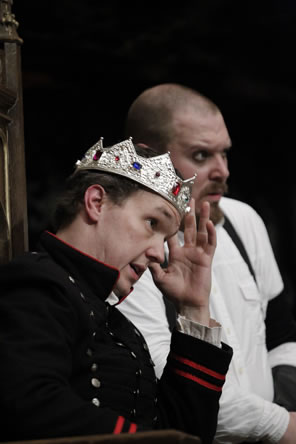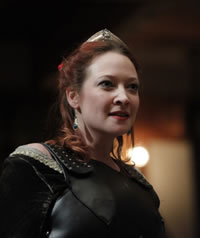Henry VI, Part 3
A Date with Destiny:
Watching Genius Emerge
American Shakespeare Center, Blackfriars Playhouse, Staunton, Va.
Saturday, March 19, 2011, L–6&7 (left of stage, “Lord’s Chairs”)
Actors' Renaissance
Season
Time machines are fascinating to think on; they’re even better to experience. Until the technology catches up to our desires, people use reenactments, old photographs, and museum wares as transports to the past.
We just experienced going back in time to visit that moment when Shakespeare became Shakespeare, and our vehicle was watching Henry VI, Part 3 as played by the ASC during the Actors' Renaissance Season with the actors, sans director, using only prompt copy and a few days to mount the play.

John Harrell as Edward of York finally gets the crown with the help of his brother, Richard, played by Benjamin Curns. Below, Sarah Fallon plays Queen Margaret, wife of the titular king in this production of Henry VI, Part 3 at the Blackfriars Playhouse. These three towering talents were at the apex of this production, mounted during the Actors' Renaissance Season with only cue scripts, no director, and a few days' rehearsal. Photo by Tommy Thompson, American Shakespeare Center.
This was the play that prompted the first recorded mention of Shakespeare as a playwright. In his 1592 death-bead diatribe, Robert Greene quoted from Part 3 in calling Shakespeare an “upstart crow…with his tiger’s heart wrapt in a player’s hide.” The original line of the play (“O, tiger’s heart wrapt in a woman’s hide”) had to be well known enough for Greene’s pun to work, evidence that the play was a hit and Shakespeare a rising star. Seeing the play in 2011 performed at the Blackfriars in its original conditions allowed us to see in person the moment Shakespeare the playwright separated himself from his peers and to watch his genius just beginning to bloom.
Typical of Elizabethan drama in the early 1590s, the Henry VI plays are a sequence of two-dimensional historic characters making heroic proclamations instead of fully fleshed creations engaging in conversation or poetic interactions. They are artificial by today’s standards when we read the text or watch a modern interpretation. Yet, when a troupe of actors steeped in Shakespearean texts and practiced in mounting plays Renaissance-style confidently inhabit these characters, we begin to see—especially in this third part—further dimensions unfold and Shakespeare’s wider worldview take hold. When Henry made both Warwick and Clarence his protectors, I found myself squirming in my seat, almost agitated enough to lean over that fourth wall and shout, “Stop, you fool!” I wasn’t alone. Later when Edward York seized on Henry and proclaimed himself king, out of the audience came a clear “No!” John Harrell as Edward pointed and scowled in the direction of the outburst suggesting he could and would remove the head of any member of the audience who spoke against him.
At the apex of this production were three towering talents: Harrell, Benjamin Curns, and Sarah Fallon. Harrell’s Edward was heroic enough, but he also wore his lasciviousness on his sleeve and was steeped in arrogance. Curns, who left an indelible impression as Richard killing Somerset at the end of Part 2 a year ago, did more than merely bridge his character with the bottled spider of the next play. He already was expressing in word and glances a delicious villainy wrapped in his heroic ideology. Curns’ Richard craved the crown above all else, deified it, saw in its compass the ultimate state of both power and contentment that any mortal could ever achieve. He genuinely wanted his brother to attain that state but only so that he could get it for himself, sooner preferably to later.
 Fallon continued her triumphant turn as Margaret. In many roles—especially, in a direct comparison, her portrayal of Tamora in Titus Andronicus—Fallon combined sexuality, wiles, and will power in playing evil women; not so her Margaret. Drawing from textual descriptions of her as being anything but a woman (i.e., a tiger, a she-wolf, and, worse, a man), Fallon’s Margaret was all warrior, clad in leather armor, striding forward confidently to kill. She slapped her weak husband and matched line for line the macho knights’ rhetoric. Yes, she fainted upon the death of her son, but Hastings (Chris Johnston) brought her to by breaking her finger, and she instantly spewed defiant curses at her Yorkist enemies. This last scene of Margaret’s in the Henry plays anticipated her totally unhistoric but prominent role in Richard III. Shakespeare obviously couldn’t banish her from his factional realm (either that or the popularity of his creation spurred him to bring her back in his next play).
Fallon continued her triumphant turn as Margaret. In many roles—especially, in a direct comparison, her portrayal of Tamora in Titus Andronicus—Fallon combined sexuality, wiles, and will power in playing evil women; not so her Margaret. Drawing from textual descriptions of her as being anything but a woman (i.e., a tiger, a she-wolf, and, worse, a man), Fallon’s Margaret was all warrior, clad in leather armor, striding forward confidently to kill. She slapped her weak husband and matched line for line the macho knights’ rhetoric. Yes, she fainted upon the death of her son, but Hastings (Chris Johnston) brought her to by breaking her finger, and she instantly spewed defiant curses at her Yorkist enemies. This last scene of Margaret’s in the Henry plays anticipated her totally unhistoric but prominent role in Richard III. Shakespeare obviously couldn’t banish her from his factional realm (either that or the popularity of his creation spurred him to bring her back in his next play).
While these three portrayals powered the play forward, this production had some other notable performances. Jeremy West took over the role of Richard Plantegenet from René Thornton Jr., who had played the rebellious York in the first two parts. West delivered his Rutland eulogy and death speech with the genuine passion necessary for the audience to view Margaret’s subsequent cruelty toward him in stark, discomforting contrast. Tyler Moss, the company’s madcap clown in most productions, turned in a mighty powerful Earl of Warwick, clearly someone who could crown and uncrown kings at will. Johnston raged through his roles as Lord Clifford and, later, as Lord Hastings (it will be interesting to see whether his Hastings, impetuous and virile, continues in Richard III next year), and between these two hard-ass roles gave us a delightfully affected but commanding King Lewis XI.
Ironically, one key character that hasn’t had a consistent portrayal over the course of ASC’s Henry VI trilogy’s three-season arc is the title character. Alyssa Wilmoth played Henry in Part 1 as young and baffled. Denise Burbach took the scepter for Part 2 and fervently aimed for moral good amid a rapidly deteriorating situation. Gregory Jon Phelps played Henry in Part 3, and while he is one of our favorite actors and did a memorable performance as Suffolk in the first two parts, his Henry seemed listless and distant. Henry is described by Warwick as a man of “coldness” even in the heat of battle and “easy melting” like wax, and in one scene his attempts to be heard were wholly ignored by both his faction and his enemies. Thus, listless and distant may have been an intentional, true-to-the-text interpretation.
Nevertheless, however worthless a king he may have been, Henry is the centerpiece to this historical tragedy, and the part needs to be that anchor. When Henry looks on York’s severed head, he expresses true foreboding; but what we saw was little more than an “ew!” response. Henry's speech on the molehill is the play's moral core, but we're anticipating Margaret or Edward or Warwick to come rushing back into our conscience. Finally, when Henry met his demise, he finally showed backbone, matching Richard insult for insult; but by this time we didn't feel this man merited sainthood, and his death was just the ridding of one more Lancastrian at Richard's hands. Thanks to Curns' interweaving bitterness and relish in this climactic moment, not only did the balance of power between the houses of Lancaster and York inexorably shift on the stage, the balance of emotions in the audience had shifted, too. As Richard gloated, we looked forward to his ascension to the titular role in next year’s installment of this tetralogy, but had no feelings of regret that true goodness had breathed his last. This production could have been more aptly titled Richard III, Part 1 rather than Henry VI, Part 3.
Still, by any title, this production illustrated how Shakespeare attained new heights as a playwright, the first of many increasingly higher heights he would scale.
Eric Minton
March 21, 2011
Comment: e-mail editorial@shakespeareances.com
Start a discussion in the Bardroom



 Find additional Shakespeareances
Find additional Shakespeareances